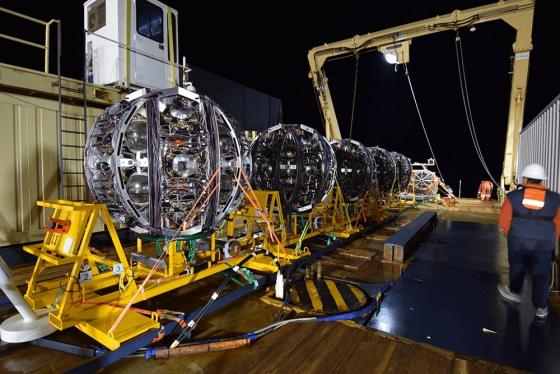The international KM3NeT collaboration is building an underwater telescope dedicated to measuring neutrinos from the depths of the Universe. The infrastructure will be divided into two sites: KM3NeT-ARCA off the coast of Capo Passero (Sicily) at a depth of 3500 m and KM3NeT-ORCA off the coast of Toulon (France) at a depth of 2500 m.
The elementary unit of the detector is the ‘optical module’, i.e. a sphere with a diameter of 43 cm housing 31 photomultiplier tubes, light radiation detectors sensitive to the faint signal produced by the interaction of neutrinos in the proximity of the detector.
The optical modules are organised in long chains (650 m in the case of KM3NeT-ARCA) called ‘strings’, each housing 18 optical modules. In total, the KM3NeT detector will have 3 building blocks (1 for KM3NeT-ORCA, 2 for KM3NeT-ARCA) each consisting of 115 strings, for a total of almost two hundred thousand detection units.
The Italian site will be dedicated primarily to measurements of astrophysical interest such as the measurement of very high energy neutrinos from various sources, such as the Galactic centre or distant active galactic nuclei.
The KM3NeT-ARCA string installation campaign started on 7 April and lasted eight days. In the port of Malta, the strings were loaded onto a platform vessel and reached the installation site after a navigation of about 9 hours. During the operations, inspections were carried out on the only string already present in the water, a new junction box was installed (which allows the power supply of the strings and the transmission of data to shore) and 5 new strings were installed.
At present, the KM3NeT-ARCA detector has 104 fully operational optical modules, whose data will soon be used to detect the first neutrinos.
Building such a large and complex detector requires the collaboration of a large number of scientists and technical experts. The KM3NeT collaboration, led until last February by Professor Mauro Gino Taiuti of the University of Genoa, includes 56 research institutes from 16 countries.
The Genoese contribution is important, with the participation of the Genoa Section of the National Institute of Nuclear Physics (INFN) and the University of Genoa. The Department of Physics hosts one of the integration sites of the KM3NeT detector where the optical modules are organised as strings and tested before being installed at sea. Of the 5 strings involved in the last marine campaign, 3 were integrated in the Genoese laboratory, which also contributed with the integration of 6 other strings that will be installed in subsequent campaigns.
Researchers from the INFN Section and the University of Genoa, coordinated by Vladimir Kulikovskiy and Matteo Sanguineti, are also working on several studies to maximise the sensitivity of the future detector to potential astrophysical neutrino sources and analysing data for cosmic ray studies.
The six installed lines include acoustic sensors used to reconstruct the dynamic positioning of the detector. The Genoa group is also using these sensors to monitor the activity of cetaceans in the area.
The next installation campaigns are planned in the next summer, but the success of the first installations is very encouraging. This is the first step towards the construction of the world’s largest undersea neutrino telescope.


